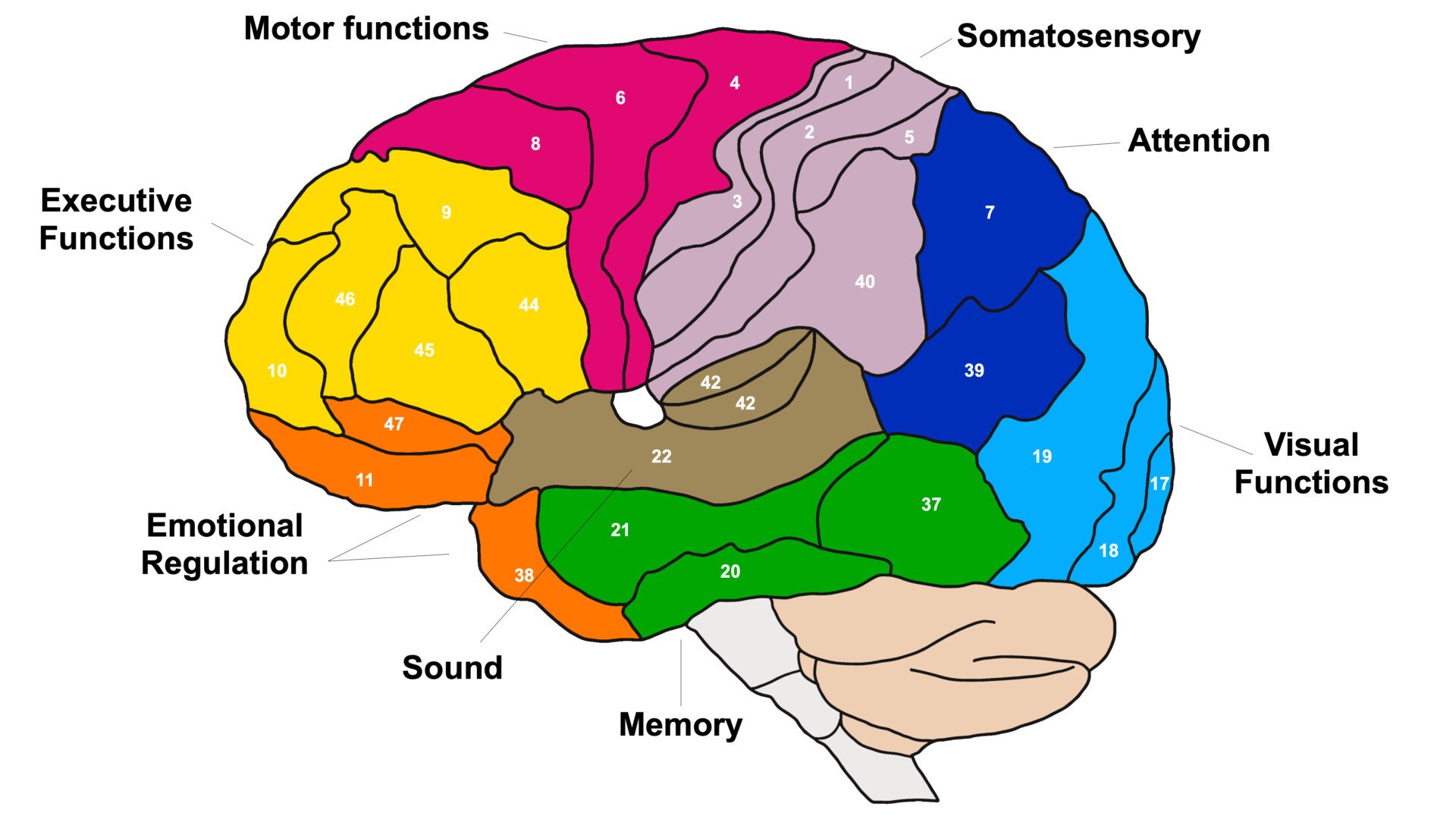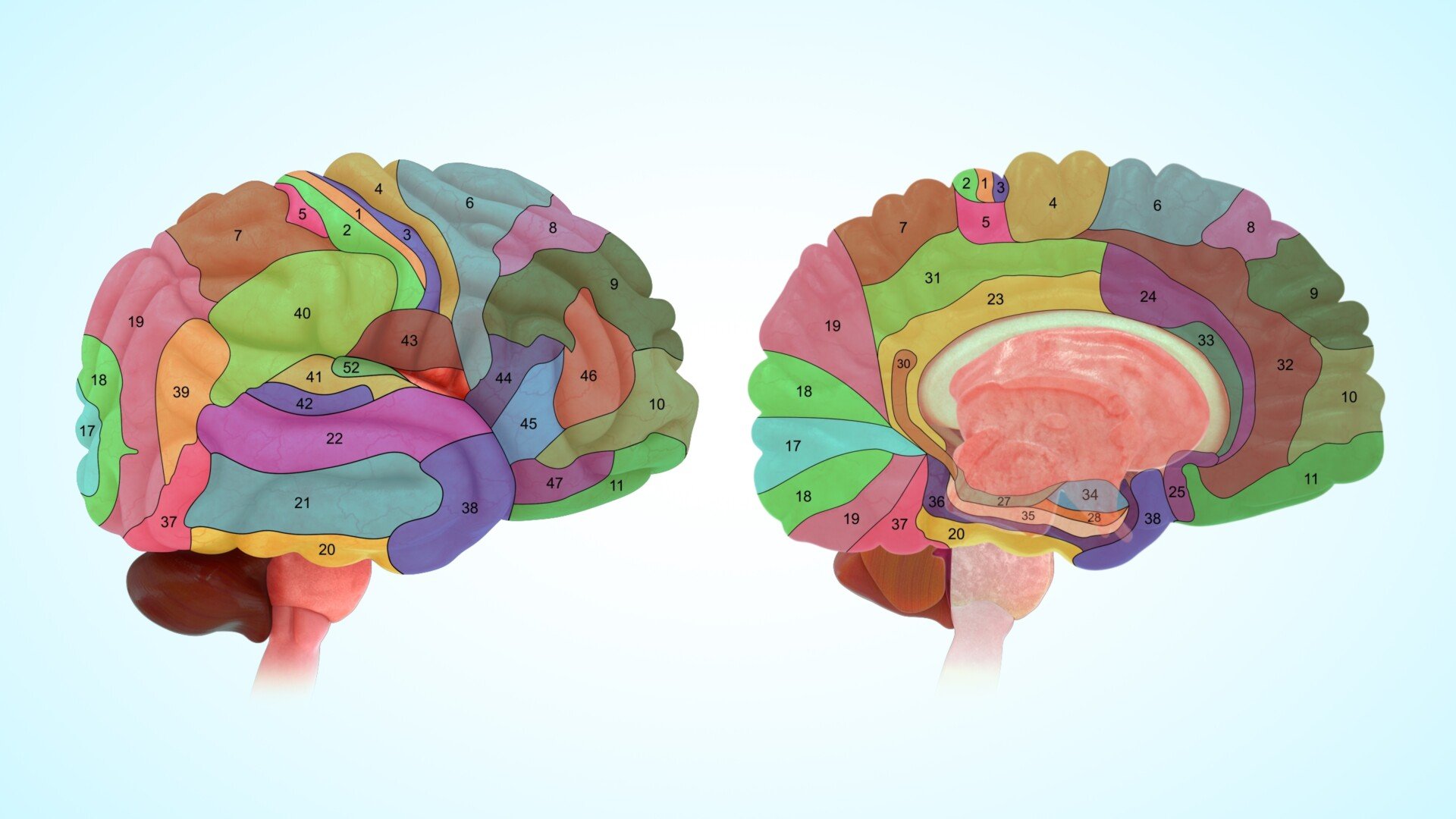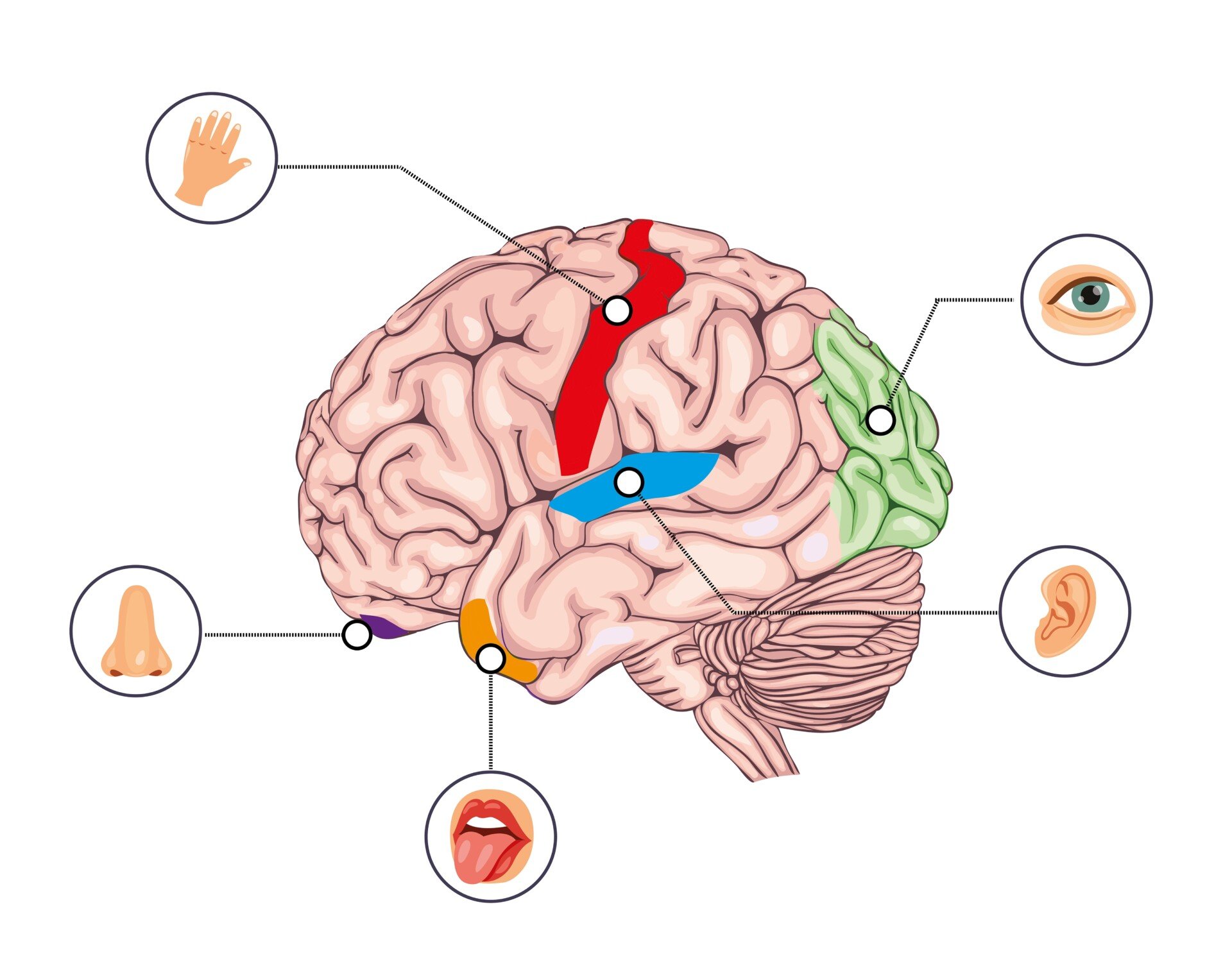Ever wondered how scientists pinpoint which parts of the brain control specific functions like vision, movement, or language? One powerful tool they use is the Brodmann map – a system that divides the cerebral cortex into 52 distinct regions, each linked to specific roles in behavior, sensation, and cognition.
Developed by German neurologist Korbinian Brodmann in the early 1900s, this system is based on differences in how brain cells are organized under a microscope.
While some areas have since been refined or expanded, Brodmann’s map remains a widely used reference in both neuroscience and psychology today.

Key Takeaways
- Brodmann areas divide the cerebral cortex into 52 regions based on the structure of brain cells.
- Each area is linked to specific functions, such as movement (Area 4), vision (Area 17), or language (Areas 44 and 45).
- These regions are still widely used in brain research, neuroimaging, and clinical diagnosis today.
- Brodmann’s map helps bridge the gap between anatomy and function, making it easier to study how the brain works.
- Despite being developed in 1909, Brodmann’s system remains one of the most reliable and referenced tools in neuroscience.
Key Brodmann Areas and Their Functions
Areas 1, 2, and 3 – Processing Touch and Sensation
Brodmann areas 1, 2, and 3 make up the primary somatosensory cortex.
This part of the brain is located in the postcentral gyrus, which sits in the parietal lobe, and it’s where your brain processes sensory information coming from your body.
These three areas work together as a team, processing sensory signals from the thalamus – a relay station for information coming from your skin, muscles, and joints.
The primary somatosensory cortex helps you feel things like touch, temperature, and pain.
It also tells you where your body parts are without looking – that’s called proprioception.
It also plays an important role in fine motor control and motor learning by helping coordinate movement based on sensory input.
What is the relationship between the primary somatosensory cortex and the primary motor cortex?
The primary somatosensory cortex helps your brain keep track of where your body parts are during movement and sends feedback to the motor areas to make your movements smooth and coordinated.
This sensory area sits right next to the primary motor cortex, just on the other side of the central sulcus.
Together, they form a team called the sensorimotor cortex, working closely to help you both sense and move your body effectively.
Area 4 – Controlling Movement
Brodmann Area 4 is a part of the brain called the primary motor cortex.
It sits in the frontal lobe and is important because it controls the movements you make on purpose, like picking up a cup or walking.
This area helps start and organize your voluntary movements. It makes sure your muscles work together smoothly when you do things like waving your hand or smiling.
It also helps plan and sequence movements in the right order, so your actions are coordinated and fluid – whether you’re tying your shoes or playing an instrument.
Brodmann Area 4 controls movement on the opposite side of your body. That means the left side of your brain moves the right side of your body, and the right side moves the left.
For example, to move your left leg, the right hemisphere’s motor cortex is activated.
Area 9 – Thinking, Planning, and Decision-Making
Brodmann Area 9 is part of the dorsolateral prefrontal cortex, which sits in the frontal lobe of your brain. It mainly covers parts of the middle and superior frontal gyri.
This area is really important for higher-level thinking – things like working memory, paying attention, making decisions, solving problems, and managing overall executive control.
It also plays a big role in regulating emotions, guiding social behavior, and helping with self-awareness—all key jobs of the prefrontal cortex.
Because it’s so involved in thinking and feeling, researchers often study Area 9 when looking at mental health issues like depression, schizophrenia, and ADHD.
It’s a major focus in studies of neuropsychiatric disorders and brain imaging.
Area 9 connects with many other parts of the brain, helping bring together different kinds of information so you can think clearly and make good decisions.
Area 17 – Seeing and Interpreting Visual Information
Brodmann Area 17, also called the primary visual cortex or V1, is located in the occipital lobe at the back of the brain.
It’s the very first part of the visual cortex where the brain begins to process what your eyes see.
This area handles the initial visual information coming from your eyes, detecting simple features like edges, shapes, and movement.
It plays a crucial role in helping you make sense of the visual world.
You’ll find Brodmann Area 17 along the calcarine fissure, a groove in the cerebral cortex of the occipital lobe.
It’s often called the striate cortex because of a distinctive stripe called the line of Gennari, visible in one of its layers (layer IV), where many nerve fibers from the thalamus arrive.
Inside this area, there’s a detailed map of the visual field – this means every point you see corresponds to a specific spot in the cortex, a process known as retinotopic mapping.
Brodmann Area 17 processes key visual features like line orientation, where things are in space, and movement.
It also helps combine information from both eyes, which is important for creating a unified image and understanding depth – this is called binocular integration.
Once Brodmann Area 17 finishes its initial processing, it sends the information to nearby areas like visual area V2 and V3.
These areas handle more complex aspects of vision like color, shape, and motion.
Area 21 – Understanding Language and Meaning
Brodmann Area 21 is located in the middle temporal gyrus, part of the temporal lobe, and plays an important role in how we process language and memory.
This area helps us understand both verbal and non-verbal communication by processing sounds and meanings, supporting auditory processing, language comprehension, semantic memory, and speech processing.
It also helps interpret social cues like tone of voice and facial expressions, which are key for effective communication.
Area 21 works closely with other language regions, including Wernicke’s area in Brodmann Area 22, which is essential for understanding language.
When this area is damaged or not working properly, it can lead to language difficulties like aphasia.
It’s also involved in conditions such as Alzheimer’s disease and other neurodegenerative disorders that affect language and memory.
Area 22 – Comprehending Speech and Social Cues
Brodmann Area 22 is located in the superior temporal gyrus of the cerebral cortex, primarily in the left hemisphere.
It plays a major role in auditory processing, language comprehension, and speech perception.
A specific part of this area, called Wernicke’s area, is found in the posterior superior temporal gyrus of the left hemisphere.
It is one of the brain’s key language centers, crucial for understanding language, processing meaning (semantic processing), and interpreting speech.
Damage to Wernicke’s area can cause Wernicke’s aphasia, resulting in language impairment and difficulties comprehending speech.
In most people, the left hemisphere is dominant for language due to brain lateralization and language dominance.
Brodmann Area 22 connects with Broca’s area and other parts of the language network, supporting speech production.
In the right hemisphere, Brodmann Area 22 is involved in processing melodic and tonal aspects of speech, such as prosody – the rhythm and intonation that give speech its emotional tone.
Areas 23, 24, 28, and 33 – Emotions and Memory
Brodmann areas 23, 24, and 28 are all part of the limbic system, which plays a big role in emotion and memory.
Areas 23 and 24 belong to the cingulate cortex – Area 23 is in the posterior cingulate gyrus, while Area 24 is in the anterior cingulate gyrus.
Brodmann Area 28 is located in the entorhinal cortex, deep in the medial temporal lobe.
These areas help regulate emotions, respond to pain, and form emotional memories. S
Area 23 is involved in processing emotions, feeling pain, creating emotional memories, and even helping with social communication.
It also plays a part in learning from emotional feedback and avoiding negative experiences.
Area 24 focuses on regulating emotions, motivation, detecting errors, and controlling automatic body functions like heart rate.
Area 28 is essential for forming memories and processing smells, thanks to its location in the entorhinal cortex of the medial temporal lobe.
All three areas are closely connected through neural pathways, forming networks that support emotional responses and memory functions.
Together, Brodmann areas 23, 24, and 28 play important roles in emotional processing, memory, and other cognitive functions within the limbic system.
Areas 44 and 45 – Producing Language
Broca’s area, located in the inferior frontal gyrus (IFG) of the frontal lobe, is made up of two parts:
The pars opercularis (Brodmann Area 44) and the pars triangularis (Brodmann Area 45). Together, they coordinate the motor planning needed to produce speech and write.
This area plays a big role in language processing – helping you structure sentences, choose the right words, and manage the rhythm and grammar of what you say.
Area 44 mainly handles the motor side of speech, controlling how your face, tongue, and larynx move during talking.
Area 45 focuses on understanding meaning (semantic processing) and grammar, as well as planning speech movements.
Broca’s area helps you formulate speech, organize sentences, and process grammar, making sure your language flows smoothly.
If Broca’s area gets damaged, it can cause non-fluent aphasia, where people struggle with grammar (agrammatism), have unusual speech rhythm (dysprosody), and face other speech production difficulties.
Interestingly, a reduction in gray matter volume in Area 45 has also been linked to psychotic symptoms seen in schizophrenia.
Brodmann Areas by Location and Function
Below is a breakdown of where all of Brodmann areas are located:
Frontal Lobe Areas
- Area 4 – Primary Motor Cortex
Controls voluntary movements for specific body parts. - Area 6 – Premotor and Supplementary Motor Cortex
Involved in planning and coordinating movements. - Area 8 – Frontal Eye Fields
Regulates voluntary eye movements and visual attention. - Areas 9, 10, 11, 12, 46, 47 – Prefrontal Cortex
Supports working memory, decision-making, attention, emotion regulation, and task planning. - Areas 44 & 45 – Broca’s Area
Essential for speech production and language structure.
Parietal Lobe Areas
- Areas 1, 2, 3 – Primary Somatosensory Cortex
Processes touch, pain, temperature, and body position. - Areas 5 & 7 – Somatosensory Association Cortex
Integrates sensory input for perception and spatial awareness. - Area 39 – Angular Gyrus
Involved in reading, number processing, memory, and attention. - Area 40 – Supramarginal Gyrus
Supports phonological processing and emotional interpretation.
Temporal Lobe Areas
- Areas 20, 21, 22 – Inferior, Middle, and Superior Temporal Gyri
Process sound, language, semantic memory, and social communication. Wernicke’s area is found in Area 22. - Area 38 – Temporal Pole
Linked to face recognition, emotion, and high-level visual memory. - Areas 41 & 42 – Primary Auditory Cortex
First cortical relay for hearing.
Occipital Lobe Areas
- Area 17 – Primary Visual Cortex (V1)
Processes basic visual input like light, shape, and movement. - Area 18 – Secondary Visual Cortex (V2)
Refines visual information from V1. - Area 19 – Associative Visual Cortex (V3–V5)
Enables higher-level visual tasks like motion detection and object recognition.
Limbic and Related Areas
- Areas 23, 24, 28–33 – Cingulate Gyrus
Regulates emotion, pain, attention, and memory. - Area 25 – Subgenual Area
Linked to mood regulation and rich in serotonin transporters. - Area 26 – Retrosplenial Motor Region
Involved in motor learning. - Area 27 – Piriform Cortex
Associated with the sense of smell. - Area 29–31 – Retrosplenial and Posterior Cingulate Cortex
Involved in memory, navigation, and the brain’s default mode network. - Areas 34–36 – Entorhinal and Perirhinal Cortex
Crucial for working memory and memory consolidation. - Area 37 – Fusiform Gyrus
Plays a role in facial recognition and complex visual processing. - Area 48 – Retrosubicular Area
Supports emotional processing and spatial orientation. - Area 52 – Parainsular Area
Important for attention and detecting salient stimuli.
Brodmann Areas Map

Brodmann Areas List


The Origins of Brodmann’s Map
Korbinian Brodmann was a German neurologist who really changed how we understand the brain’s structure.
Back in 1909, he published a detailed map of the cerebral cortex based on something called cytoarchitecture – which is just a fancy way of describing how brain cells are organized.
By studying tissue samples from humans and other mammals under the microscope, Brodmann noticed that different parts of the cortex had unique layers, cell types, and patterns.
He divided the cortex into 52 numbered areas, giving scientists a clear, organized way to talk about brain regions that were previously a bit chaotic to name.
While some areas like Broca’s and Wernicke’s were already known for their role in language, Brodmann’s map showed the bigger picture of how the whole cortex is laid out functionally.
His work was groundbreaking and laid the foundation for many discoveries about how different brain areas support things like behavior, thought, and sensation.
Brodmann’s approach helped us understand the brain’s complex structure by focusing on the tiny details of neuron types and their arrangement in the brain’s cortical layers.
He revealed this through careful histology and microscopic study.
Why Are Brodmann Areas Still Relevant Today?
Even though Korbinian Brodmann mapped the brain over a century ago, his work remains a cornerstone of modern neuroscience and psychology.
Why? Because Brodmann areas offer a consistent, structured way to describe the brain’s surface – and link its anatomy to function.
These numbered regions are still used in research, brain imaging (like fMRI), and clinical practice to locate and describe specific parts of the cortex.
For example, neuroscientists studying memory activation may refer to Brodmann area 37, while a neurologist investigating speech loss might focus on areas 44 and 45.
While some areas have been subdivided or refined with newer imaging technologies, Brodmann’s map is still one of the most practical and widely recognized systems for understanding the brain.
Why Are Brodmann Areas Still Relevant Despite Advances in Imaging Technologies?
Even though modern brain imaging techniques like fMRI and PET let us see brain activity in real time, scientists still need reliable landmarks to make sense of what they’re seeing.
That’s where Brodmann areas come in – they act like a standardized map of the brain’s surface that helps researchers and doctors pinpoint exactly which part of the brain is doing what.
On top of that, while imaging shows which areas light up during tasks, Brodmann’s work explains why those areas handle certain functions by looking at the brain’s detailed cellular structure.
This link between how the brain is built and what it does is still really important, especially when planning brain surgery or diagnosing neurological problems.
References
Brodmann K. 1909. Vergleichende Lokalisationslehre der Grobhirnrinde in ihren Prinzipien dargestellt auf Grund des Zellenbaues. Leipzig: J.A. Barth
Carter, R. (2019). The Human Brain Book: An Illustrated Guide to its Structure, Function, and Disorders (3rd ed). DK.
Ferng, A. (2021, May 31). Brodmann areas. Kenhub. https://www.kenhub.com/en/library/anatomy/brodmann-areas
Hacking, C. Gaillard et al., (n.d.). Brodmann areas. Radiopaedia. Retrieved August 6, 2021, from: https://radiopaedia.org/articles/brodmann-areas?lang=gb
Further Reading
- Šimic, G., & Hof, P. R. (2015). In search of the definitive Brodmann’s map of cortical areas in human. Journal of Comparative Neurology, 523(1), 5-14.
- Judaš, M., Cepanec, M., & Sedmak, G. (2012). Brodmann’s map of the human cerebral cortex—or Brodmann’s maps?. Translational Neuroscience, 3(1), 67-74.

